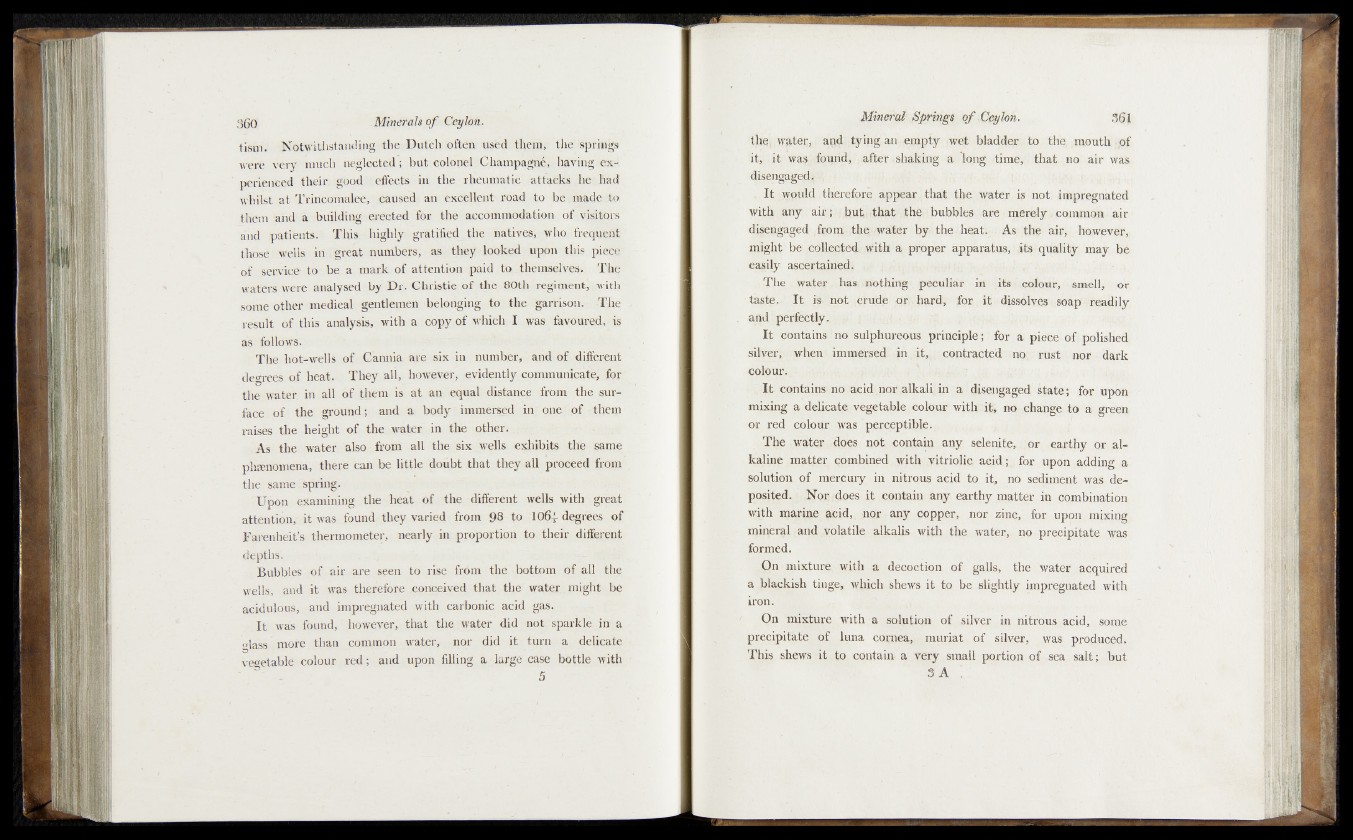
tisai.? • bsfed: fhein, the! [spring
\?ere very:fmuch mgleqted; but'colonel Champagné, having experienced
theicüigèod! ; effects in the rheumatic ;attacks.^h©'--Had'
whilst at Trincomalee^; caused:- art _êx<?ëllent- roaj^nt^'belmde'.to
them ‘and a buildingiéMeted for th© aceofenrodabjoir, o f;vMldrs
and patients.-, This highly gratified the natives, whpr frequent
thósè’.wells in [great numbers, as they looked upon %is; pie^?
of service to be a mark of attention paid tó^thems©ïyé,sx
wate^weie analysed by Dr. Christie of the 80th regipmnty with'
some other medical gentlemen belonging to the garrison.,, ;-The
result of this analysis, with a copy of-which I was fayppreid’,, is
as fellows:
The h'ot-wells of Cannia are six in number,.;: andrp£ different
degrees of heat. They all, however, evidentlyk^mmunicatei jfor
tlie water in all of them is a t an equal distance-from ^ § .^ u r-
4-faceN o£ the ground; and a, body immersed tfcem
raises the height of the water in thé o th e r...
, As the water also from all the six „wells" exhibits the same
phenomena, there can be little doubt that they all. proceed ffrcan
the same .spring.
Upon examining the heat of the different wells with great
attention, it was found, they varied from 98 to 1Ö6* degrees of
Earenheit’s thermometer, nearly in. proportion |ó their different
depths.
Bubbles of; air are seen to rise fróm the bottom of all the
wells, and it was therefore conceived that the water..might bp
acidulous, and impregnated with carbonic acid gas.
I t was found, however, that the water did ‘not, sparkle in a
glass . more than common water, nor did it turn a delicate
vegetable colour red ; and upon filling a large case bottle with
5
tiiej.wateji^ and tying!,an-empty rwef^bladder*.to the,;rtiouth,?f©f
it,v it wa%,}foqjid,,,,after .-shafting a long, (time, that jHOi .air was
4isengqge^fit;
- I t wauld., therefore appfao tha^t the. water is not( impregnated
with any ai^; but, that the, bubbles.^ce, merelyl^pommon a ir5
di^ebgaged rfi?0nv,;;felj^.fWa|er by-the * heat: -As-the airy howpvfer,,
mlght be-^ollcptedi With a proper apparatus, ,its- qualify, may be
€Ej|ily ascertained'« ».*
• (yjie , wafter ,. has-, »nothing peculiar in its fVcblqur, .smell, ot
fefbe.. I t is-.not ^eludp «qr.hard; Jor it dissolves soap^.readily
and perfectly.;, f.
I t e1^k.th,ihsd no %MphurCOus, principle; for, a* ©i^sqi'of|ppiished,
siiyer'i when- immersed^,|hjit*,; „contracted mo; rust- nor dark
colour ^ ; j
I t Contains-no acid noi?-alkali-in a disengaged state; for upon
mixing a^de^catp-,vegetable, colour witlvitl no^chapge to a? green,
or red, cofqyrii-.was percpptiblg.,.
The water.,does not.^cqptaiij any, selemte,^|pr, earthy or-alkaline
matter combined with .vitriolic aqjsd,;,, for upon, adding, a
splution of mercury in Jq|rqus.ayid1 rto it, no sedijnejnt -was.de-
ppsited.;:,^oi};does it contain any earthy matter, in .combination
n ^ h maripe acid,, jnqr.rany copper, nor zinc, for ..upon^ixing
njin^rgl £and.»volatile qlkalis with the water,, ^po EpE©cipifeate yas
formed.
,Qn -mixture with a decoction of, galls, t,he '}vs$ef „ acquired
a blackish tinge* which 'shews it to be ^lightly impregnated with
iron.,.IS
On mixture with, a solution of .silver .in. nitrous«acidf
precipitate of luna copieaf ;muriat of..- silver, was,,produced.
This shews it .to contain a Very small portion of sea salt; biit
3 A ;